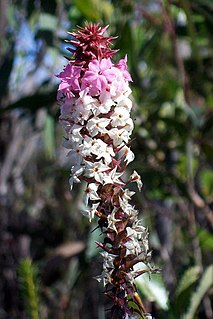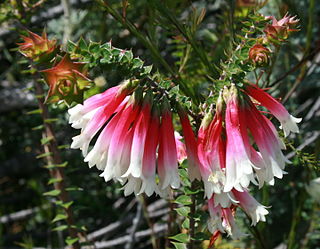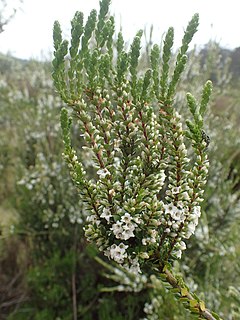
Epacris impressa, also known as common heath, is a plant of the heath family, Ericaceae, that is native to southeast Australia. French botanist Jacques Labillardière collected the species in 1793 and described it in 1805. Four forms have been identified, but no subspecies are recognised. Growing in heathland, shrubland or open forest, it is generally a small shrub around 0.5 to 1 m tall, with small stiff leaves. The red, pink or white tube-like flowers appear from late autumn to early spring. Honeyeater birds, particularly the eastern spinebill, feed upon the nectar of the flowers. It regenerates after bushfire by seed or by resprouting.

Epacris is a genus of about forty species of flowering plants in the family Ericaceae. It was formerly treated in a closely related but separate family Epacridaceae, but the various genera within Epacridaceae including Epacris have been revised in their relationships to each other and brought under the common umbrella of the Ericaceae. The genus Epacris is native to eastern and southeastern Australia, New Caledonia and New Zealand. The species are known as heaths or Australian heaths.
Rupicola is a small genus of flowering plants in the family Ericaceae. The species are endemic to New South Wales in Australia.
The Australian Native Plants Society (Australia) (ANPSA) is a federation of seven state-based member organisations for people interested in Australia's native flora, both in aspects of conservation and in cultivation.

Woollsia is a monotypic genus in the family Ericaceae. The sole species, Woollsia pungens, known as snow heath, is a small shrub found in eastern Australia, from Pigeon House Mountain in southern New South Wales north into Queensland.

Epacris longiflora, commonly known as the fuchsia heath, is a plant in the family Ericaceae and is endemic to eastern Australia. It is an erect or spreading shrub with egg-shaped, pointed leaves and red tube-shaped flowers which give the plant its name longiflora and are usually present throughout the year. Its native range extends from the central coast of New South Wales to southern Queensland.

Grevillea oldei is a shrub which is endemic to New South Wales in Australia.
Epacris glacialis is a plant species of the genus Epacris. It is endemic to Australia. The species forms a prostrate or decumbent shrub, between 5 and 30 cm high. The leaves are crowded on the branchlets and are 2 to 4 mm long and 1.5 to 2.5 mm wide. White flowers appear in small clusters between December and January in the species' native range.

Astroloma humifusum, commonly known as the native cranberry or cranberry heath, is a small prostrate shrub or groundcover in the heath family Ericaceae. The species is endemic to south-eastern Australia.

Epacris purpurascens var. purpurascens is rare Australian plant from the heath family. Commonly known as the Port Jackson heath, this small plant grows in swamps and scrubby country on sandstone based soils around the Gosford and Sydney region of central eastern New South Wales. See also Epacris purpurascens var. onosmiflora.

Epacris microphylla , commonly known as coral heath, is a plant in the heath family Ericaceae and which is endemic to eastern Australia. It is a common, wiry shrub with tiny leaves that are often obscured by the flowers, especially near the ends of the stems. The plant sometimes grows in dense groups, giving the effect of a snowfall.

Lomatia myricoides, commonly known as the river lomatia, is a shrub native to New South Wales and Victoria in southeastern Australia.

Epacris obtusifolia is common plant from the heath family. The blunt-leaf heath grows in swampy areas and heathland in eastern Australia. It is usually seen growing less than a metre tall. Flowers form in any time of the year, but are mostly seen between July and January.

Monotoca scoparia, commonly known as prickly broom heath, is a widespread native species across south-eastern Australia. Monotoca scoparia was formerly in the family Epacridaceae but now belongs to the family Ericaceae. Monotoca is an endemic Australian genus with 17 described species occurring in all states.

Epacris rhombifolia commonly known as mountain coral heath, is a plant in the heath family Ericaceae and is endemic to eastern Australia. It is an erect, multi-stemmed shrub with broad, rhombic leaves and white flowers with four petals, the flowers spreading down the branches. It only grows in wet, subalpine heath and is sometimes regarded as a variety of Epacris microphylla.

Epacris serpyllifolia, also known as alpine heath, is a plant of the family Ericaceae, that is native to southeast Australia: the states of Tasmania, Victoria and New South Wales. Growing in heathland, sup-alpine and/or mountainous areas, it is generally a small shrub around 0.3 metres to 1.2 metres in height, with small stiff leaves. White tube-like flowers appear from spring to early summer. It regenerates after bushfire by seed or by resprouting.

Epacris lanuginosa, commonly known as woolly-style heath or swamp heath, is a riparian angiosperm. Its conservation status is listed as 'Not threatened'.
Epacris petrophila, commonly known as the snow heath is a low-lying shrub, 30-60 cm in height with flowers in short leafy clusters. Epacris petrophila is in the Epacridaceae plant Family.

Epacris sparsa, is a small upright shrub with creamy-white flowers, elliptic to egg-shaped leaves and reddish new growth. It is endemic to New South Wales with a restricted distribution.

Epacris browniae is a plant species in the family Ericaceae.

















